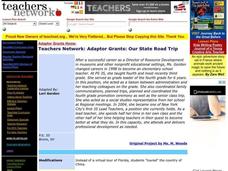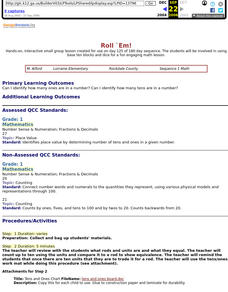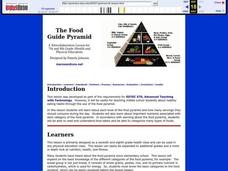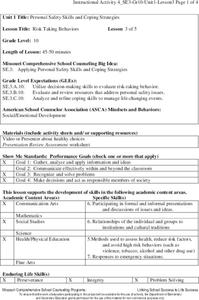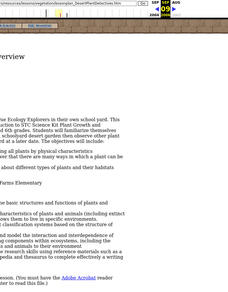Curated OER
Simple Harmonic Motion
Students study harmonic motion and its oscillation. In this simple harmonic motion lesson students demonstrate a series of regular oscillations and explain the theory behind the experiment.
Curated OER
Geography Made Fun with Technology
Students incorporate knowledge box into their classroom activities. In this technology integration lesson, students fill out a graphic organizer using Glossopedia to analyze a new subject.
Curated OER
Catch Me if You Can
Third graders investigate behavioral and physical adaptations, such as camouflage, that allow animals to respond to life needs.
Curated OER
"For the Birds" [part I]
Students identify birds that appear in Chinese and Japanese art, learning about
their physical characteristics, classifying them according to scientific principles, and exploring their habitats and migration patterns. This is part one...
Curated OER
Our State Road Trip
Students take a virtual tour of the country of China instead of a state. Using the Internet, they examine the differences between a political and physical map and use latitude and longitude to locate specific places. They also research...
Curated OER
Winter Animal Match
Students play a game. In this matching lesson, students learn about animals and their winter homes. Students match cards of animals with the cards of winter homes.
Curated OER
Box of Chocolate Adjectives
Students practice using descriptive words. In this adjectives lesson plan, students are given a piece of candy and write as many descriptive words as they can about the candy. Students make sure to use descriptions that include all...
Curated OER
A Day in the Life of a Leprechaun
Pupils investigate creative writing by reading Leprechaun stories. In this Irish culture lesson, students listen as their teacher describes what a leprechaun is and where the idea for the creature came from. Pupils write a fictional...
Curated OER
Roll `Em!
First graders engage in using base ten blocks and dice for a fun engaging math activity. They use a worksheet imbedded in this activity as the game board to help them play this math game.
Curated OER
State Your Mission
Students explore state history and geography that correspond with classroom lessons.
Curated OER
Molecules
Young scholars combine movement with science in this fun integrated lesson plan. When students are "liquid" they can "melt" or "ooze" at the end and when they are are "solids" they can "freeze" in a shape.
Curated OER
Heritage Deer
Students trace body parts to create a deer in this excellent Kindergarten lesson that teaches basic Art skills and cultural awareness. The lesson includes a materials list, vocabulary used, a bibliography, and is best suited for use...
Curated OER
Healthy Choice Shopping Frenzy
Students identify the four food groups. In this food pyramid lesson plan. students use pictures of food to determine what food group they belong to. Foods that are placed in the wrong place are discussed.
Curated OER
How Does Your Garden Grow?
Students create a design for a school garden. In this garden design lesson, students analyze what plants grow best in their school's climate and work in teams to design a garden. Students measure the existing space, determine the...
Curated OER
Environmental Education
Second graders examine how their choices affect the environment. They identify different types of pollution and its source. They ask questions to end the lesson.
Curated OER
Circuit City
Fifth graders are introduced to the concept of circuits and how electricity works. In groups, they design their own subdivision with houses in which they have inside and outside light sources. To end the instructional activity, they...
Curated OER
Magnetic Attraction
Second graders create a hypothesis on what objects will attract to magnets. In this magnets lesson plan, 2nd graders use a computer program to create a hypothesis as to what will attract or unattract magnets. For an extension, they test...
Curated OER
The Sine Function
Students explore the concept of the sine function. For this sine function lesson, students use a plexiglass sine wave generator to visualize the sine function. Students use a computer program/calculator to adjust aspects of the sine...
Curated OER
The Food Guide Pyramid
Students examine each level of the food pyramid and how many servings they should consume during the day. They study the important nutrients associated with each category of the food pyramid.
University of Colorado
Planetary Distances on the Playground
Earth is 149,600,000 km, or 92,957,130.4 miles, from the sun. Young astronauts create an interactive model to learn the distances between planets. Nine groups, each representing a different planet, are spread around at class-calculated...
Laboratory for Atmospheric and Space Physics
A Classroom Solar System
Create a scaled model of our solar system in your classroom! Scholars work collaboratively to build paper mache planets and hang them in their proper position to showcase each planet's location in the solar system.
Missouri Department of Elementary
Fatal Accident
While there may not be any ghostbusters in the neighborhood, there are plenty of emergency response agencies ready to give support if something is amiss. To that end, instructors invite a member of an emergency response agency to address...
Missouri Department of Elementary
Risk Taking Behaviors
Sophomores can be sometimes wise and sometimes foolish. The same can be said for their behaviors. After watching a presentation about risk taking behaviors, class members discuss the presentation in small groups, and then complete a...
Curated OER
Desert Plant Detectives
Students examine and categorize plants in their own schoolyard desert garden and then observe other plant areas of their schoolyard.



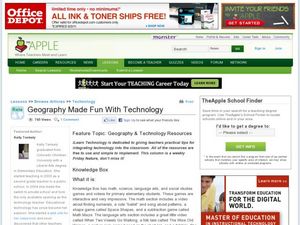

!["For the Birds" [part I] Lesson Plan "For the Birds" [part I] Lesson Plan](http://content.lessonplanet.com/resources/thumbnails/122462/large/cgrmlwnvbnzlcnqymdeymtaxny0ynji5lwd4n2h5by5qcgc.jpg?1414222903)
